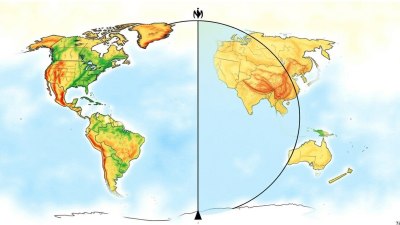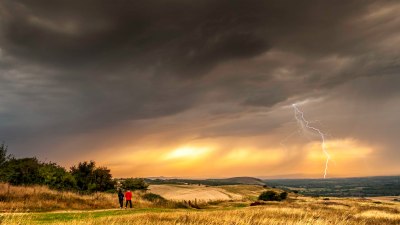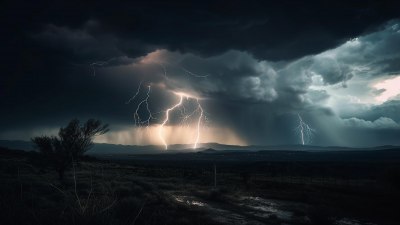What Causes “Pop-Up” Storms on Hot Afternoons
Explore the science behind pop-up storms that occur on hot afternoons, including their formation, characteristics, and weather patterns.

Image created with Flux Schnell
Pop-up storms, also known as air-mass thunderstorms, frequently appear on hot afternoons, especially in the summer months. These localized storms develop rapidly, often seeming to materialize out of nowhere, then dissipate just as quickly. Understanding what causes these sudden weather events involves examining the atmospheric conditions, the role of solar heating, and moisture availability contributing to their formation and behavior.
What Are Pop-Up Storms?
Pop-up storms are small, short-lived thunderstorms that occur mostly in the warm season and typically arise due to surface heating. Unlike large storm systems such as frontal thunderstorms or squall lines, pop-up storms tend to be isolated, sometimes occurring miles apart. They are often seen during the afternoon hours, coinciding with the peak of solar heating, which fosters the right conditions for their growth.
These storms generally form beneath an unstable atmosphere—a condition where the air is buoyant and can rise freely. They are closely linked with convective activity, involving warm air rising due to thermal gradients near the surface. Given their sudden appearance and localized impacts, pop-up storms can be challenging to predict accurately, posing particular risks for outdoor activities and areas prone to flash flooding.
The Role of Solar Heating
The primary driver behind pop-up storms is the intense solar heating of the earth’s surface on hot days. As sunlight warms the ground, energy is transferred to the air just above it. This warming causes near-surface air parcels to heat convectionally, becoming buoyant and starting to rise through the surrounding cooler, denser air. This rising motion is a fundamental part of thunderstorm formation.
During midday and early afternoon, when sunlight is strongest and the surface temperature is typically at its peak, the conditions are ripe for strong thermals (columns of rising warm air). These thermals can lift moisture-laden air from the surface up to higher altitudes, where the air cools and condensation can occur. If the instability in the atmosphere is high enough, it supports this buoyant motion, enabling cloud development and eventually storm formation.
Atmospheric Instability and Moisture
Atmospheric instability is a critical ingredient in the development of pop-up thunderstorms. Instability means that the surrounding air is cooler than the rising parcel of air, allowing the parcel to continue to ascend. This situation occurs when the environmental lapse rate (the rate at which air temperature decreases with height) exceeds the adiabatic lapse rate of the rising air parcel.
Without sufficient atmospheric instability, the rising air will stall and sink back, preventing storm development. Moisture is equally essential; water vapor must be present in the lower atmosphere to feed the formation of clouds and precipitation. When the rising air cools to its dew point, condensation occurs, releasing latent heat that further fuels the upward motion and storm growth.
Typical Locations for Pop-Up Storm Development
Pop-up storms are most commonly found in regions with warm, humid climates, such as the southeastern United States during summer. However, they can happen in many places around the world that experience strong surface heating and ample moisture. Flat or gently rolling terrain often facilitates their development by minimizing disruptions to the warm air’s rise.
Mountainous regions can also experience pop-up storms, but the orographic influence usually produces larger-scale storms as air is forced upward along slopes. In contrast, pop-up storms form more due to localized heating rather than terrain forcing or frontal boundaries.
The Lifecycle of a Pop-Up Storm
Pop-up storms generally follow a three-stage lifecycle: the cumulus, mature, and dissipating stages. In the cumulus stage, thermal updrafts cause moist air parcels to rise and form cumulus clouds, which grow vertically as long as the upward motion persists.
When the clouds reach a significant height, the mature stage begins, characterized by strong updrafts and downdrafts. During this phase, precipitation forms and falls, lightning and thunder become frequent, and the storm can cause brief but intense weather impacts such as heavy rain, gusty winds, and brief hail episodes.
The dissipating stage starts once the downdrafts dominate, cutting off the warm air supply. Without continued lift and moisture, the storm quickly weakens and evaporates, often within an hour of initiation. This lifecycle explains why pop-up storms are typically short-lived and confined to small areas.
Factors Influencing Pop-Up Storm Intensity
The intensity of pop-up storms is influenced by several atmospheric factors. The amount of moisture available near the surface directly affects rainfall rates and potential storm strength. Higher humidity results in more vigorous condensation and latent heat release, increasing storm intensity.
Wind shear, or the change in wind speed and direction with height, is generally low in pop-up storms because they form in weakly sheared environments. This lack of shear tends to limit storm longevity and organization but does not prevent storm genesis.
The presence of an inversion, a stable warm layer aloft, can inhibit storm growth by capping upward motion. When this cap is broken, however, explosive storm development can ensue as the accumulated heat and moisture are released rapidly.
Common Weather Patterns Associated with Pop-Up Storms
Pop-up storms often appear in regions dominated by high pressure during summer, where surface heating is intense but large-scale weather systems are absent. These high-pressure systems typically bring warm, stable air aloft but permit strong heating near the surface, enhancing convective potential.
On days with highly variable cloud cover, bursts of sunlight passing through gaps can trigger localized heating sufficient to initiate pop-up storms. These storms may also develop ahead of advancing cold fronts or outflow boundaries from other storms, which provide additional lift.
Unique Hazards and Impacts
Although short-lived, pop-up storms can produce hazards such as sudden heavy rainfall leading to flash flooding, especially in urban or poorly drained areas. The quick onset of these storms can catch people off guard, posing dangers to motorists, hikers, and outdoor workers.
Additionally, pop-up storms can generate lightning strikes that threaten people, livestock, and infrastructure. Sudden gusty winds can damage trees, signs, and power lines. In some cases, small hail can accompany these storms, causing localized property or crop damage.
Challenges in Forecasting Pop-Up Storms
Forecasting pop-up storms is difficult because they depend on small-scale processes and surface conditions that may change rapidly. Weather models generally lack the resolution to capture the minute atmospheric variations leading to their initiation.
Meteorologists rely on satellite data, surface observations, weather balloon soundings, and radar to identify areas prone to thunderstorm development. Yet the exact timing and location of pop-up storms can remain elusive until they begin forming visually.
Forecasters often issue general advisories for widely unstable days with sufficient moisture, warning the public about the potential for scattered afternoon storms. However, predicting each storm's exact appearance remains a challenge in operational meteorology.
Mitigation and Safety Tips
Because pop-up storms develop quickly, public awareness is essential for safety. Monitoring local weather forecasts and radar during hot afternoons can provide advance notice of storm activity. Avoiding open fields, tall isolated trees, and water bodies during thunderstorms reduces risks of lightning strikes.
Seeking shelter indoors at the first signs of thunder or lightning is recommended. In regions where flash flooding is common, staying alert to changing weather and moving to higher ground promptly can save lives.
Impact of Climate Change on Pop-Up Storms
Climate change may affect the frequency and intensity of pop-up storms by altering temperature and moisture patterns. Warmer air holds more moisture, potentially enhancing convective energy and storm development.
Increased heat waves could lead to more days with the necessary instability for these storms. However, changes in atmospheric circulation and local factors add complexity to predicting exact outcomes. Ongoing research aims to understand how shifting climate conditions will influence the behavior and risks associated with air-mass thunderstorms.
Pop-up storms are short-lived, isolated thunderstorms that form primarily due to surface heating on hot afternoons when the atmosphere is unstable and sufficient moisture is present. Their lifecycle entails rapid development from cumulus growth to mature storm with precipitation, followed by swift dissipation due to downdrafts. They pose hazards such as sudden heavy rain, lightning, and gusty winds, complicating safety and forecasting efforts.
Understanding the driving atmospheric conditions helps meteorologists provide timely guidance and helps individuals recognize the warning signs to minimize risks during such weather events. These ephemeral but impactful storms highlight the dynamism of convective weather phenomena in warm climates.











